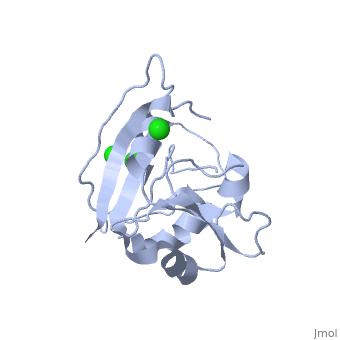User:Karan Hingorani/sandbox 2
From Proteopedia
| Line 16: | Line 16: | ||
===Drug Target=== | ===Drug Target=== | ||
| - | + | Since DHFR is so critically positioned in the metabolic homeostasis of all organsims it has been the target of choice for anti microbial and anti cancer therapy. Inhibitors of this enzyme are essentially folate mimics, methotrexate which was first designed to inhibit <scene name='User:Karan_Hingorani/sandbox_2/Humandhfr_nad_metho_1/1'>Human DHFR</scene> and used as therapy for cancer and autoimmune disorders. Another folate mimic Trimethoprim was developed as an anti bacterial agent, having much more binding specificity to bacterial DHFR than its mammalian counterpart. Both drugs bind in the active site of the enzyme and are irreversibly bound thus ablating enzyme activity.[http://www.ncbi.nlm.nih.gov/pubmed/16477649] [http://www.ncbi.nlm.nih.gov/pubmed/15681865?dopt=Abstract]. | |
Templates used on this page: | Templates used on this page: | ||
Revision as of 16:35, 15 December 2011
|
Dihydrofolate Reductase (DHFR) is a crucial metabolic enzyme whose function is to reduce Dihydrofolate to Tetrahydrofolate, which can then be incorporated into the synthesis of Purines and amino acids. DHFR is classified as an oxidoreductase, which uses NADP+ as the electron acceptor (EC: 1.5.1.3). It is ubiquitously found and is now a popular target for anticancer drugs and antibiotics. free of any of its ligands is displayed here.
Contents |
Structure
E.coli DHFR is a small 159 amino acid protein approximately 18kDa. It has an a/b structure with eight central B strands and four helices. The protein can be thought to be made up of two subdomains, divided by the active site cleft. The which consists of residues 38-88 and the major subdomain comprised of about 100 residues. Three loops can be found in the major subdomain and they make up about 50% of this domain. They are the (residues 9-24), the (residues 116-132)and the (residues 142-150). The Met20 loop assumes different conformations during catalysis and accomodation of ligands is made possible by the 'hinge bending' motion about Lys 38 and Val 88 of the Adenosine binding domain.
Catalysis
DHFR catalyzes the reduction of 7,8-dihydrofolate to 5,6,7,8-tetrahydrofolate using reduced Nicotinamide Adenine Dinucleotide Phosphate (NADPH). This system has been key model to decipher enzyme catalysis and the intermediates of the catalytic cycle have been identified by crystallography. CPMG relaxation NMR experiments have also revealed that intermediates in the catalytic cycle exist in equilibrium with the preceding or following intermediate. Thus the binding of ligands seems to happen via a conformational selection rather than the traditional view of induced fit which is used to explain conformation change on ligand binding. shows the ligands Dihydrofolate and NADP+ positioned in the active site cleft.
Drug Target
Since DHFR is so critically positioned in the metabolic homeostasis of all organsims it has been the target of choice for anti microbial and anti cancer therapy. Inhibitors of this enzyme are essentially folate mimics, methotrexate which was first designed to inhibit and used as therapy for cancer and autoimmune disorders. Another folate mimic Trimethoprim was developed as an anti bacterial agent, having much more binding specificity to bacterial DHFR than its mammalian counterpart. Both drugs bind in the active site of the enzyme and are irreversibly bound thus ablating enzyme activity.[1] [2].
Templates used on this page:
PDB structures
2cbr - hCRABP I – human
1cbr - CRABP I + retinoic acid – mouse

